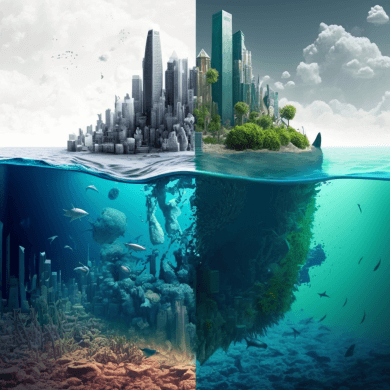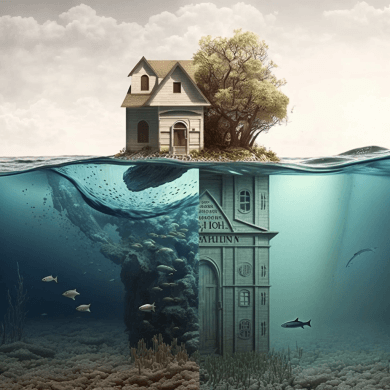What is Sea Level Rise?
Sea level rise is the increase in the volume of water in the world’s oceans, resulting from warming temperatures. As water warms up, it expands and takes up more space. This causes sea levels to rise higher than they were before.
Sea level rise is caused by two main factors: melting polar ice caps and thermal expansion (the expansion of ocean water as it gets warmer). Melting ice caps cause fresh water to enter our oceans–a process called glacial melt–which displaces saltier seawater underneath it. This makes those areas less dense than normal seawater and therefore causes them to float higher on top of their new neighbors’ heads!
What are the Impacts of Sea Level Rise?
The impacts of sea level rise are varied and complex. They include:
Impact on Coastal Ecosystems
Impacts on coastal ecosystems, including coral reefs and mangroves. These ecosystems provide critical habitat for many species and protect land from storms, erosion and flooding. As the ocean rises, these habitats will be lost or damaged.
Impact on humans living in coastal areas
Impacts on humans living near the coast who depend on natural resources such as fisheries and tourism for their livelihoods. People living in low-lying areas will be most vulnerable to flooding during storms or high tides; this can affect homes, crops and livestock (for example farmers who rely on fresh water).
How Can We Reduce Sea Level Rise?
(1)Reduce greenhouse gas emissions.
(2)Invest in adaptation strategies.
(3)Restore coastal wetlands and mangroves, which help to buffer against sea level rise by protecting the shoreline from erosion caused by waves and tides.
What are the Current Solutions to Sea Level Rise?
There are a number of strategies that can be used to combat rising sea levels. Coastal protection measures, such as seawalls, dikes and levees help prevent flooding by keeping the water out of low-lying areas. Relocation of people who live in these areas is another option; however, this can be difficult due to the high cost involved and lack of affordable housing options elsewhere.
Finally, there are adaptive strategies that allow people to live with rising sea levels rather than try to fight them head on or move away from their homes entirely.
What is the Future of Sea Level Rise?
As the climate warms, sea levels will continue to rise. It’s possible that we could see as much as 1 meter of sea level rise by 2100, and even more beyond that.
The impacts of this will be felt most strongly by coastal communities around the world: low-lying islands like Kiribati and Tuvalu; coastal cities like New York City; and small towns in Alaska where people rely on fishing boats for their livelihoods. These places are already at risk from storms and flooding–and now they face an additional threat from rising seas as well!
What Can We Do to Prepare for Sea Level Rise?
The most important thing we can do to prepare for sea level rise is to educate ourselves and others about it. We also need to invest in adaptation strategies, such as improving coastal protection measures and relocating buildings away from flood-prone areas.
What are the Economic Impacts of Sea Level Rise?
The economic impacts of sea level rise are wide-ranging, but they can be grouped into three categories:
Impact of Coastal Enterprises
Impacts on coastal businesses. Many businesses rely on the ocean for their revenue. As sea levels rise, these businesses will be forced to relocate or close down because of increased flooding and erosion. For example, in 2017 Hurricane Irma hit Florida’s Key West area hard–the storm caused widespread damage to property and infrastructure as well as lost tourism revenue from visitors who couldn’t reach the island during their vacations (or chose not to).
Impact of Tourism
Impacts on tourism. When tourists come visit your city or town, they spend money at hotels, restaurants and other local businesses; this spending helps boost your local economy by creating jobs and generating tax revenue for government services like schools or police departments. But if tourists aren’t able get there due to flooding caused by rising seas levels then there won’t be any new visitors coming through town! This means less money being spent locally which could lead down a slippery slope towards bankruptcy if left unchecked over time…
What Are the Policy Solutions to Sea Level Rise?
There are many policies that can be implemented to address rising sea levels. These include international agreements, national policies, and local regulations.
International Agreements:
An example of an international agreement would be the Paris Agreement on Climate Change (2015). This agreement was signed by 195 countries and aims to keep global temperatures from rising more than 2 degrees Celsius above pre-industrial levels by 2100. It also aims to limit the increase in average global temperature even further–to 1.5 degrees Celsius above pre-industrial levels–by 2100.
What Are the Social Impacts of Sea Level Rise?
The impacts of sea level rise are likely to be most severe for those who are already vulnerable. For example, the poorest communities tend to live in areas that are most susceptible to flooding and other hazards caused by climate change.
Displacement is another major issue associated with rising seas: As coastal areas become uninhabitable due to flooding, people may have no choice but to relocate inland or further away from their homes. This can have devastating effects on cultural heritage as well as economic opportunities if they’re forced into unfamiliar environments where they don’t know anyone or don’t speak the language.
Conclusion
The impact of rising sea levels on the world’s coastlines is a major concern. If left unchecked, it could have devastating consequences for coastal communities and ecosystems. The good news is that there are many things you can do to help prevent or mitigate the effects of rising seas–from reducing your carbon footprint to supporting legislation that encourages sustainable development practices.
If you’re concerned about how climate change will affect your community and what steps need to be taken in order to prepare for it, then this guide has everything you need!

